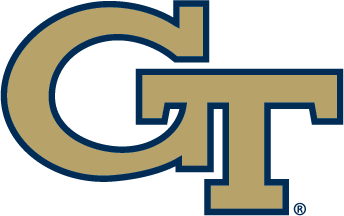June 22, 2016
By Matt Winkeljohn – For all of his virtues and value as an integrator, Bruce Heppler is not especially patient, so it’s remarkable that he smiles so broadly. His latest dream – the Noonan Golf Facility, a state-of-the-art golf practice range near Georgia Tech’s campus – is coming on-line, which prompts starry-eyed grins. Yet it’s nearly killed the coach.
The intricately re-designed 13-acre spread between 14th and 16th streets has been delayed and delayed again to where those who know Heppler might think it a miracle that he’s still standing to see it across the finish line.
Or, they might consider this a case study of a visionary who has camped out as a squatter might, to get what he wants no matter the hurdles thrown up.
Some green parts of the facility, named for lead donors Kim P. (IM, 1983) and Thomas E. Noonan (ME, 1983) won’t be usable until football season and Tech must wait until mid-fall for two small buildings if the latest schedule holds, but the Jackets began hitting balls there in mid-April.
That was enough for Heppler, who’s helmed Tech to 11 ACC titles in 21 years as head coach, to invoke golf’s mecca: Augusta National.
As good tools for practice and recruiting, the $13 million project will be an oasis in the midst of desert, the sands in this case being the very big city of Atlanta. That, he believes, is perfectly in line with the Georgia Institute of Technology.
“The campus as it was in 1995 [when Heppler was hired] no longer exists,” the coach opined. “The good news is all the [recruits] we see who’ve been to all these pretty little college towns and their beautiful campuses, by the time [they] visit, they think they’re going to Harlem or Watts.
“You look at the new buildings, see what’s here and because the expectations have been set so low, campus blows most people away. It’s a little bit like driving down Washington Road in Augusta. No big deal, right? But you make a right turn and head down Magnolia Lane, and it’s life-altering because of the contrast.”
The difference between what was (nothing when Heppler was hired) and what will be — a putting green, a double-green chipping area, four par-3 greens, a team clubhouse and a hitting barn for student-athletes to open garage doors during the winter to drive – is like a shank to a straight bomb off the tee.
Stewart Cink played for Tech before Heppler was hired, yet he’s joined Matt Kuchar as the primary donors to the project among former Jackets. Cink said he’d like to use the place occasionally even though he typically practices near his home at Sugarloaf in Duluth.
“It won’t be just curiosity. It’s a good practice facility, but it’s also quite private,” Cink said. “Really, my son is a freshman at Georgia Tech, and it will be great to see him, have lunch, catch up with his life and practice.”
It’s taken a few mulligans to get here.
When Heppler arrived at Tech, the Jackets did not have practice contracts with East Lake and the Golf Club of Georgia as they do now (Heppler, assistants and donors raise funds for memberships at both clubs).
They had some access to Druid Hills, practiced occasionally outside the perimeter at the Atlanta Golf Center with instructor George Kellenhoffer, and at a few other locations.
“Back then, we had almost 14 guys on the team,” he said. “We’d call around, get a tee time for qualifying, that’s five tee times … take your army of ants out there and descend on the golf course. What if that day there’s four inches of rain?
“You know what you do? You play because you don’t get to go out there tomorrow. Those guys that were here the first couple years will tell you that we played in some horrendous conditions.”
Soon, Heppler noticed land near campus.
“I was driving around, trying to figure out how to solve a problem,” he said. “I saw the softball field and 11 or 12 acres that was the dump and asked, ‘Who owns this?’ The answer was the [Georgia Tech] Foundation.
“Charlie Brown was a [golf] booster, and involved with [former athletic director] Homer [Rice] in establishing the golf program. He was on the real estate committee of the thing, and he said, ‘What are you thinking?’ I said I’d like to clean it up and hit some balls there.”
Before long, the golf program rented land near the old softball field.
Tech also eventually joined East Lake and the Golf Club of Georgia. Those are fantastic courses, but they’re not available every day, they’re off campus, and they don’t have facilities that favor working on short games.
The old, simple practice facility nearly went away when the 13 acres and more property around it went under contract and “Then, 2008 happened,” he said.
After the land deal fell through and the property returned to the Foundation, “that’s when I really tried to convince enough people that we needed to do something here.”
Finally, as the Jackets continued to win and win while posting perfect APR scores of 1000 annually, Tech president Dr. G.P. “Bud” Peterson and the GTAA made an earnest commitment to its most successful program. The GTAA bought the 13 acres from the Foundation.
Heppler prefers thinking about that rather than delays that have come up since.
“At the end of the day, when you’ve waited 18 years, 19 years or whatever, I want to focus more on the days like when Dr. Peterson felt like this is something the school needed to do, needed to support golf,” Heppler said. “He supports it, which allows athletics to support it.”
After the GTAA bought the property from the Foundation, the Jackets needed a design. Heppler worked with Tom Marzoff of Fazio Golf Design, and players added ideas.
Kuchar and Cink have been the primary financial contributors among former Tech players, and both have design ideas that are being implemented. Roberto Castro has chimed in, too.
Kuchar, who has won about $36 million as a touring pro since graduating in 2000, visited last September while in Atlanta to play in the PGA Tour Championship at East Lake.
“I was quite impressed. It looked awesome. It’s a place I certainly look forward to having access to, challenge the guys to a few competitions,” he said. “I suggested a serpentine-style green [with multiple targets] … I dragged my foot in the dirt, and sketched on a pad as well.”
Cink, who has won nearly $34 million since graduating in 1995, did not have a practice facility during his time at Tech, and he didn’t play for Heppler.
He pitched in money and an idea, though, because he believes in the missions – plural – of Tech and its golf program. He feels that a “false green,” or one that slopes back toward the fairway while appearing level and safe for approach, ought to be part of the picture.
“I graduated from Georgia Tech, and I’m proud of the institution and the golf program, and that’s what I’m inherently investing in,” he said. “I’ve seen what it can do for the skills of players.
“I think what good players — like Tech players — think about that scares them and me is what you need to practice the most. I always thought that tight, really closely mowed grass is more threatening to golfers, areas where the ball will roll away from your target, like the ninth [green] at Augusta.”
Kuchar, Cink and other Jackets have helped in multiple ways. With $600,000 or so contributed by former Tech players, fund-raising jumped, and the GTAA’s debts of about $9 million for property acquisition and $4 million in renovation expenses were reduced.
“Matt made as much of a warm and fuzzy about the place as anyone because after he graduated, he used it all the time until he moved to Sea Island,” Heppler said. “Stewart lives at Sugarloaf and obviously doesn’t need to use it. He still understood the value of the deal.
“Their money mattered, and it changed the opinions of a lot of donors. A lot of them asked, ‘What about the guys who benefitted from it the last 18 years?’ To be able to say this is what former players have done … that made them feel good about what we’ve done before [and donate again].”
There would be more expense, however, and plenty of delays.
When state officials deemed the facility property a wetlands, even though there are no natural water supplies on the property, that meant that Heppler could do nothing with a water retention pond nearly in the middle of new plans.
Eventually, Tech had no choice but to keep the pond but negotiated to move it.
That took time, yet worked out with financial help from others.
“We moved [the pond] a little bit. It’s smaller and deeper but it retains just as much water,” Heppler said. “We moved it up the range so it’s in a real narrow part. We tried to move it a little and make it smaller to have more usable area.”
The delays caused by that and the building permit problems that came with it pushed back grounds-keeping plans, and eventually fetched another issue.
Re-configuring the retention pond was not simple.
“In the middle of building a wall around it, engineers decided there wasn’t any compactable soil so there had to be a huge dredging and excavation and then stone, rock and gravel brought in to provide a base for the wall,” Heppler explained. “That turned into a 10-week delay with the wall, and a cost run-up.”
All the construction delays, which were exacerbated by the modest size of the property and the fact that there isn’t much room to move equipment and inventory around while working on one area vs. another, delayed installation of the most prominent asset.
The growing of grass is a tricky deal in the best of circumstances.
Intermittent heavy rain in the fall further delayed the process. The goal was to sprig seed over most of the property, but it got so late in the season that it became clear that waiting for the right time to do that could become problematic.
There was an over-riding goal to get grass in before winter hit full force so that the Jackets could use the facility by late spring – at least six months later than originally expected.
“When we decided to try to finish this winter, we found out how much it would be to change all those sprigs to sod and we had people step forward to the tune of about $110,000 to get the thing sodded before the rains came,” Heppler said.
“The good news was we got all that sod down before the 20 inches of rain came in December, and had we not done that the place would’ve just washed away and we would have had to re-do all the grading.”
Heppler did not study for this as an undergraduate at Brigham Young, where his major was accounting. And he sure didn’t pursue it while earning a master’s in sports management at Massachusetts.
His school of hard knocks, though, has taught him to persevere.
Much of the sod is rooted, and the still-sand-and-dirt greens will be sprigged next month when the soil will be warm enough at night to nurture the Bermuda. By mid-to-late summer, the greens should be good to go, and by next fall the Jackets will be all the way back on track.
Construction on two modest buildings, including a clubhouse and hitting barn with video and digital teaching equipment, should begin in early summer and wrap up by mid-fall.
Tech assistant coach Jeff Pierce, who continues to travel to work with the professional clients he gained at Butch Harmon’s Floridian, will teach out of the new facility while maintaining his job alongside Heppler.
That figures to be attractive to recruits. So do the practice facility and Tech alumni.
“Anybody who’s in the Atlanta area who is still playing professional golf or competing as amateurs, it’s great to hear ideas,” Kuchar said. “It was always great for me to see guys like Stewart Cink or David Duval around.”
Had Tech successfully sprigged everything last fall and torrential rains not come, they might be using the practice facility in full now. But if they sprigged when they planned, December’s heavy rains likely would’ve washed everything away.
“At least we can get some benefit out of it before the season is over,” he said. “It opens some eyes [among recruits]. I think the scope of it from both ways has shown the passion of the staff and from the athletic department.
“Whatever I believed about how important it was … a year without it that’s gone up 150 percent. There would be no way for us to survive long-term without it, and it will be nice to have [former players] around. The come in and work out with the guys. It changes the dynamic.”
The journey to complete the project continues, but Heppler is happy because the end is in sight.









